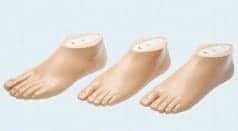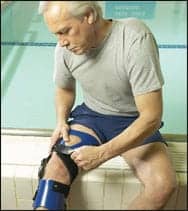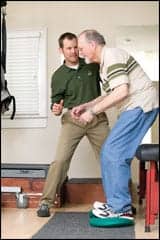 |
| Author/therapist Mike Studer, PT, MHS, NCS, oversees the balance treatment of client Fred W. Gelderman. |
There has never been a better time to grow old. The science of balance rehabilitation has improved immensely and continues to be refined through research on a weekly basis. We understand the relationships between variables of strength, activity, distractibility, and endurance and their effects on the outcomes of balance and quality of life better than ever. In this article, we will uncover the best practice recommendations about these variables in the task of balance.
Research on balance has been largely stimulated and highlighted by our awareness of the epidemic of falls, most recently by the National Fall Prevention Action Plan.1,2 In the United States alone, 30% of people over the age of 65 years and 40% of those over the age of 80 fall annually.3-5 Residents of long-term care facilities, often weaker and less able to recover from a fall, are at higher risk as up to 66% of these individuals will fall each year.3
Tinetti et al6 found that 48% of people over age 75 who had fallen in the previous year were afraid of falling, while 27% of those who had not fallen admitted having a fear of falling. Fear of falling often leads to activity restriction and diminished mobility.5-8 As many as 56% of people over age 75 restrict or curtail their activity due to fear of falling.6 Not surprisingly, quality of life and depression are influenced by postural instability—a natural progression along the International Classification of Function (ICF) model as a reduction in activities leads to reduced participation.8-10 Both fear of falling and impaired balance are treatable through balance rehabilitation with several studies citing an improvement in confidence through a balance retraining program.5,6,10-12
Recently, the American College of Sports Medicine (ACSM) and the American Heart Association13 (AHA) collaboratively released recommendations for endurance, strength, flexibility, and balance participation. These recommendations were achieved through a research review and consensus among experts. The findings are nonspecific in balance. The authors stated clear evidence that balance exercises are effective in reducing falls, yet note, “We have proof that balance rehabilitation works, yet we cannot offer a protocol or set of exercises that can be recommended/proven to work.” There is no one balance prescription for the very reason that there is no one balance problem.
Our ability to impact this multifactorial problem begins with an accurate assessment: “the purpose of tests and measures is to ensure … selection of appropriate interventions.”14 Evidence-based medicine is essential to prove our efficacy and improve our abilities. Tools most often cited to evaluate balance, fall risk, fear of falling, and functional endurance include the Timed Up and Go (TUGO),4 Tinetti Performance Oriented Mobility Assessment (POMA),15 6-minute walk test,16 Berg Balance Scale (BBS),17 Activity Specific Balance Confidence (ABC),18 and Dynamic Gait Index (DGI).19 Clearly, no one item is best in all conditions.20 Dibble et al21 suggest in their article on Parkinson’s disease that clinicians should use more than one to more accurately identify fall risk.
Using multiple tests will help to guide treatment by identifying exactly what conditions of balance are difficult for the patient. This provides a more comprehensive baseline from which the patient can progress, reflecting objective improvements. Evidence proves the efficacy of rehabilitation, supporting the need for this patient’s skilled therapy as well as reimbursement.
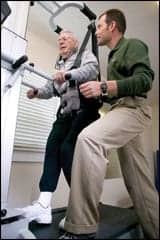 |
| Author/therapist Mike Studer, PT, MHS, NCS, oversees the balance treatment of client Melvin R. Dalton. |
PRESCRIBING TREATMENT
Balance activities may include various combinations of walking, static standing, or sit to stand transitions with eyes open or closed, head nodding or turning, firm or compliant surfaces, obstacles, and direction changes. So, with all of these possibilities, how do we choose what activity to “prescribe” for each patient? Research has helped to define best practice for certain diagnostic groups.
ADDRESSING STROKE
Recent literature on balance includes retraining through reducing hemiplegia and hemisensory impairments.22-28 Efforts to reduce hemiplegia include intense practice with encouragement to use the more affected limbs in activities such as gait with and without an assistive device, body-weight supported treadmill training (BWSTT), sit to stand, stair climbing, and various balance activities (tandem stance, single leg stance).22-26 Activities directed at reducing sensory impairment in stroke have included rehabilitating with limited to no visual input and augmented proprioceptive input.27,28 Studies using feedback through visual cues and forceplate training in stroke have as yet been inconclusive in attempts to improve dynamic balance.27-31
A FOCUS ON GERIATRIC ISSUES
Balance training research for the community-dwelling elderly has primarily focused on strength training,32-35 dual task training,36-40 and functionally based proprioception retraining.41-46 Progressive resistance training (PRT) programs have been proven to improve balance in the community-dwelling elderly and should follow the ACSM guidelines reviewed below.13,32-35,41
Balance is an automatic motor task that is typically performed with limited conscious control. When impaired, balance can require more concentration.37 With aging, some experience a reduction in cognitive resources—most notably, a reduction in the ability to filter distracting stimuli.38 When this loss is coupled with impaired balance, people have elevated fall risk in dual task situations.38,39,46 Dual task testing and training are therefore an essential component of geriatric balance programs.
Dual task performance in balance has been assessed with an array of distracters: visual, cognitive (counting backwards, subtracting, spelling backwards), auditory (identify this sound), and manual (carrying an item) while performing static (stand on one leg) or dynamic (various conditions of ambulation) tasks simultaneously.36-41 Dual task training can promote improved tolerance of distractions, and there is some suggestion that offering dual task interference will promote better motor learning.36,41
Westlake and Culham43 successfully trained elderly patients through intense sensory-specific balance conditions including combinations of narrow base of support, compliant surfaces, single limb, and eyes closed with and without dual task conditions. The authors hypothesized that the training may have forced recognition of proprioceptive inputs that may have been lost in the aging process.
COMMENTS FROM THE EXPERTS
Carol A. Giuliani, PT, PhD, professor, Department of Allied Health Sciences, University of North Carolina at Chapel Hill, and Anne Shumway-Cook, PT, PhD, professor, Department of Rehabilitation Medicine, University of Washington, Seattle, are considered two of the foremost neurologic and geriatric experts in the physical therapy field; they were recently asked to comment about what therapists have learned about balance through research in the last 10 years.
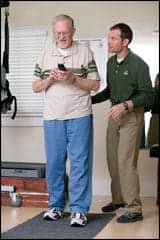 |
| Mike Studer, PT, MHS, NCS, works with client Fred W. Gelderman. According to Studer, “Balance exercises are specific to the individual.” |
According to Giuliani, “I think we have learned several things in the past 10 years—balance control requires multiple systems, not just visual, vestibular, and somatosensory. Measuring dynamic balance control does not necessarily give you information about static balance, and training static balance may not transfer to dynamic situations. What surprises me is that we seem to persist with training on standing weight symmetry using forceplate feedback in spite of multiple studies showing that although symmetry improves, functional balance does not. We also focus on leg strength as an important factor for balance, but it is becoming evident that it is only one part of the puzzle. It seems that increased strength is not always associated with increased balance.
“[Research] provides some insights in that the most effective interventions are multidimensional and include strength, balance, task training, and progressive challenges to balance. Growing evidence suggests an important role of executive function for balance and falls. We need to have a better understanding of this relationship and how our balance training programs may actually improve cognitive function. So I think we learned that narrow explorations only explain narrow passages. To understand these complex relationships, I believe that using multilevel analyses in our research studies will help us better understand the complexities of balance and falls.”
Shumway-Cook says, “Research in the past 10 years has shown us that the underlying cause of imbalance is multidimensional. Instability in an individual patient can be caused by problems in one or more of the systems essential to balance control, including motor systems, sensory systems, and cognitive systems. A key challenge to us as rehabilitation professionals is determining the best way to identify and treat the underlying cause(s) of instability in our patient.”
POST-BRAIN INJURY BALANCE TRAINING
Research on balance training after brain injury includes approaches focused on cognition, vestibular integration, strength, speed, and coordination.47-50 Recently, Thornton and colleagues49 used a virtual reality-based balance program and found patients to be engaged in the program, revealing a success in ABC score outcome. BWSTT is often and increasingly cited as an intervention for brain injury when balance is an issue.48 Patients with brain injury are a very heterogeneous group, making research on balance in this population very difficult.
ADDRESSING VESTIBULAR IMPAIRMENT
Balance rehabilitation in the patient with vestibular impairment is complex and best summarized with the Cochrane Review statement, “learning to bring on the symptoms to ‘desensitize’ the vestibular system, learning to coordinate eye and head movements.”51 This is carried out through a progressive increase in balance demands from sitting to standing to motion and under various conditions of firm to compliant surfaces and even perturbations.
GAIT TRAINING POST PARKINSON’S
Strength and power training are well established as fundamentals in programs for balance in patients with Parkinson’s disease (PD). Dibble and colleagues have investigated this with eccentric activities as have others with various concentric, high-intensity efforts.52-55
Toole and colleagues53 recently investigated the effects of treadmill training on balance in patients with PD, finding that the effect of BWSTT on balance outcomes was significant. Hermann et al56 experienced similar results in their study and indicate that walking on a treadmill improves gait, mobility, and quality of life of patients with Parkinson’s disease. Protas and colleagues used forward, backward, and sideways walking with BWSTT—suddenly turning the treadmill off to perturb their balance.57 Subjects had a reduced number of falls and improved balance outcome. Research has focused on but has had mixed results with visual cues, rhythmic training, and attempts at redirecting attention in dual task situations.58,59 As yet, there is no evidence that whole body vibration is effective for balance rehabilitation in PD.56
FOLLOWING THE ACSM GUIDELINES
“I am too old to get stronger.”
This statement is yet another myth of aging that is being debunked on a daily basis. Research has demonstrated not only strength gains in subjects older than age 65, but also the positive effect on balance through strengthening. The ACSM/AHA guidelines13 for strengthening include 3 days per week of resistance training for major muscle groups—one set of eight to 10 repetitions at a weight that can be performed 10 to 15 times by the individual.
ACSM endurance guidelines include parameters for 2 and 5 days per week. The findings state that subjects should operate at a moderate intensity level for 20 minutes 5 days per week or a vigorous level for 20 minutes 2 days per week. Recent evidence suggests that TBI, PD (studies by Margaret Schenkman, PhD, PT), and stroke patients can experience improved endurance through body-weight supported treadmill training.
To maintain flexibility, the guidelines support 2 days per week of activities that contribute to increased flexibility. No specific activities are identified in the guidelines.
Centers for Disease Control and Prevention (CDC) recommendations are consistent with those of the ACSM. According to the CDC, people over 65 years of age should participate in 1 to 7 days per week of activities to maintain or improve balance. The CDC also notes,”The effects of exercise in general are modest (a 14% reduction in falls), and the effects on falls related to injuries (injurious falls) are less clear. No evidence exists in regard to a particular exercise that may be best for preventing falls.”60 Balance exercises are specific to the individual; there is no “balance exercise” best for everyone. This is precisely why skilled therapy is indicated.
CARRYOVER—MAINTAINING THE SKILL
One of the most difficult aspects of balance rehabilitation is assigning a challenging, yet safe, home exercise program. There is limited research in this area. Speaking from experience, not evidence, I suggest:
- Keep the tasks clear and interesting/ relevant for this person with a direct tie to examination findings. (Patient perspective:”I am doing this activity because I have difficulty recognizing a loss of balance when my eyes are closed.”)
- Structure exercises such that the patients can compete against themselves. This helps to drive intensity and progress. (“Yesterday, I stood up 19 times in 1 minute from this chair. Today, I will try to get up to 20.”)
- Use tasks that require limited equipment and challenge endurance, strength, balance, and gait speed as your assessment indicates. Some suggestions:
- A 60-second sit to stand, 1x/day—race against yourself.
- A 6-minute walk test—try to go farther today.
- Sit to stand repetitions, feet on a pillow. Eyes open or closed as able.
- Limit static standing balance activities. Research has not demonstrated carryover to fall prevention or dynamic balance.
A MORE ACCURATE ASSESSMENT
The future of balance rehabilitation lies in a more accurate assessment of exactly which factors are salient in this person’s case. Through this assessment, we must establish the correct type and “dosage” of activity for each condition and each person—considering their motivation and personality. We can easily “overdose” (too much intensity, challenge, and risk) a patient who is fearful of falling. However, if the dose is not raised to a therapeutic level, we have wasted resources (patient, caregiver, therapist, and third-party payor). Rehabilitation professionals are therefore challenged to create the most task-specific conditions (relevant to this person’s environment) that will challenge the multiple systems to better recognize and organize an accurate response during a loss of balance.
As this knowledge base grows, APTA and section-member therapists have access to Hooked on Evidence, neuropt.org and geriatricspt.org, at their leisure for the latest in clinical and laboratory-based advances.
Stay in touch with the latest developments!
Mike Studer, PT, MHS, NCS, is the president and co-owner of Northwest Rehabilitation Associates Inc (www.northwestrehab.com), Salem, Ore. He can be reached at .
REFERENCES
- National Council on Aging. Falls Free: Promoting a National Falls Prevention Action Plan: Overview of the Falls Free Summit Planning Process. Washington, DC; 2005.
- National Council on Aging. Falls Free: Promoting a National Falls Prevention Action Plan. 2005. Available at: www.healthyagingprograms.org.
- Prudham D, Evans JG. Factors associated with falls in the elderly: a community study. Age Ageing. 1981;10:141–146
- Shumway-Cook A, Baldwin M, Polissar NL, Gruber W. Predicting the probability for falls in community-dwelling older adults. Phys Ther. 1997;77:812-819.
- Hatch J, Gill-Body K, Portney LG. Determinants of balance confidence in community dwelling elderly people. Phys Ther. 2003;83:1072-1079.
- Tinetti ME, Williams TF, Mayewski R. Fall risk index for elderly patients based on number of chronic disabilities. Am J Med. 1986; 80:429–434.
- Howland J, Lachman ME, Peterson EW, et al. Covariates of fear of falling and associated activity curtailment. Gerontologist. 1998; 38:549–555.
- Arfken CL, Lach HW, Birge SJ, Miller JP. The prevalence and correlates of fear of falling in elderly persons living in the community. Am J Public Health. 1994; 84:565–570.
- Jette AM. Toward a common language for function, disability, and health. Phys Ther. 2006;86:726-734.
- Deshpande N, Metter EJ, Lauretani F, Bandinelli S, Guralnik J, Ferrucci L. Activity restriction induced by fear of falling and objective and subjective measures of physical function: a prospective cohort study. J Am Geriatr Soc. 2008;56(4):615-20.
- Ashburn A, Stack E, Pickering RM, Ward CD. A community-dwelling sample of people with Parkinson’s disease: characteristics of fallers and non-fallers. Age Ageing. 2001;30(1):47-52.
- Tinetti ME, Speechley M, Ginter SE. Risk factors for falls among elderly persons living in the community. N Engl J Med. 1988;319: 1700-1707.
- Nelson ME, Rejeski WJ, Blair SN, et al. Physical activity and public health in older adults: recommendation from the American College of Sports Medicine and the American Heart Association. Med Sci Sports Exerc. 2007;39:1435-1445.
- Guide to physical therapist practice. 2nd ed. Phys Ther. 2001;81:45.
- Tinetti ME. Performance-oriented assessment of mobility problems in elderly patients. Am Geriatr Soc. 1986;34:119-126.
- Poole-Wilson PA. The 6-minute walk. A simple test with clinical application. Eur Heart J. 2000;21:507-508.
- Berg KO, Wood-Dauphinée SL, Williams JI, Gayton D. Measuring balance in the elderly: preliminary development of an instrument. Physiother Can. 1989;41:304–311.
- Miller WC, Deathe BA, Speechle M. Psychometric properties of the activities-specific balance confidence scale among individuals with a lower-limb amputation. Arch Phys Med Rehabilil. 2003;84:656-661.
- Whitney SL, Hudak MT, Marchetti GF. The dynamic gait index relates to self-reported fall history in individuals with vestibular dysfunction. J Vestib Res. 2000;10:99-105.
- Task Force on Standards for Measurement in Physical Therapy. Standards for tests and measurements in physical therapy practice. Phys Ther. 1991;71:589-622.
- Dibble LE, Christensen J, Ballard DJ, Foreman KB. Diagnosis of fall risk in Parkinson disease: an analysis of individual and collective clinical balance test interpretation. Phys Ther. 2008;88:323-332.
- Fritz SL, Pittman AL, Robinson AC, Orton SC, Rivers ED. An intense intervention for improving gait, balance, and mobility for individuals with chronic stroke: a pilot study. J Neurol Phys Ther. 2007;31(2):71-76.
- Sullivan KJ, Klassen T, Mulroy S. Combined task-specific training and strengthening effects on locomotor recovery post-stroke: a case study. J Neurol Phys Ther. 2006;30:130.
- Vearrier LA, Langan J, Shumway-Cook A, et al. An intensive massed practice approach to retraining balance post-stroke. Gait Posture. 2005;22:154-163.
- Lamontagne A, Fung J. Faster is better: implications for speed-intensive gait training after stroke. Stroke. 2004;35:2543-2548.
- Miller EW, Combs SA, Fish C, Bense B, Owens A, Burch A. Running training after stroke: a single-subject report. Phys Ther. 2008;88:511-22.
- Bonan IV, Yelnik AP, Colle FM, et al. Reliance on visual information after stroke. Part II: effectiveness of a balance rehabilitation program with visual cue deprivation after stroke: a randomized controlled trial. Arch Phys Med Rehabil. 2004;85:274-278.
- Cheng PT, Wang CM, Chung CY, Chen CL. Effects of visual feedback rhythmic weight-shift training on hemiplegic stroke patients. Clin Rehabil. 2004;18:747-753.
- Grant T, Brouwer BJ, Culham EG, Vandervoort A. Balance retraining following acute stroke: a comparison of two methods. Can J Rehabil. 1997;11:69–73.
- Walker C, Brouwer BJ, Culham EG. Use of visual feedback in retraining balance following acute stroke. Phys Ther. 2000;80:886-895.
- Geiger RA, Allen JB, O’Keefe JO, Hicks RR. Balance and mobility following stroke: effects of physical therapy interventions with and without biofeedback/forceplate training. Phys Ther. 2001;81:995-1005.
- Hess JA, Woollacott M. Effect of high-intensity strength-training on functional measures of balance ability in balance-impaired older adults. J Manipulative Physiol Ther. 2005;28:582-590.
- Runge M, Rehfeld G, Resnicek E. Balance training and exercise in geriatric patients. Musculoskelet Neuronal Interact. 2000;1(1):61-65.
- Baker MK, Kennedy DJ, Bohle PL, et al. Efficacy and feasibility of a novel tri-modal robust exercise prescription in a retirement community: a randomized, controlled trial. J Am Geriatr Soc. 2007;55:1-10.
- Steadman J, Donaldson N, Kalra L. A randomized controlled trial of an enhanced balance training program to improve mobility and reduce falls in elderly patients. J Am Geriatr Soc. 2003;51:847-852.
- Silsupadol P, Siu KC, Shumway-Cook A, Woollacott MH. Training of balance under single- and dual-task conditions in older adults with balance impairment. Phys Ther. 2006;86:269-281.
- Liu-Ambrose T, Pang MY, Eng JJ. Executive function is independently associated with performances of balance and mobility in community-dwelling older adults after mild stroke: implications for falls prevention. Cerebrovasc Dis. 2007;23(2-3):203-210.
- Healey MK, Campbell KL, Hasher L. Chapter 22 Cognitive aging and increased distractibility: costs and potential benefits. Prog Brain Res. 2008;169:353-63.
- Campbell C, Rowse J, Ciol M, Shumway-Cook A. The effect of cognitive demand on timed up and go performance in older adults with and without Parkinson’s disease. Neurol Report. 2003;27:2-7.
- Beauchet O, Dubost V, Allad G, et al. Faster counter while walking as a predictor of falls in older adults. Age and Ageing. 2007;36:418-423.
- Toulotte C, Thevenon A, Fabre C. Effects of training and detraining on the static and dynamic balance in elderly fallers and non-fallers: a pilot study. Disabil Rehabil. 2006;28(2):125-33.
- Kronhed AG, Moller C, Olsson B, Moller M. The effect of short-term balance training on community-dwelling older adults. J Aging Phys Act. 2001;9(1):19-31.
- Westlake KP, Culham EG. Sensory-specific balance training in older adults: effect on proprioceptive reintegration and cognitive demands. Phys Ther. 2007;87:1274-1283.
- Campbell M, Borrie MI, Spears GI. Risk factors for falls in a community based prospective study of people 70 years and older. J Gerontol. 1989;44:M1112-1117.
- Brown LA, Shumway-Cook A, Woollacott MH. Attentional demands and postural recovery: the effects of aging. J Gerontol A Biol Sci Med Sci. 1999;54:M165–M171.
- Brauer SG, Woollacott M, Shumway-Cook A. The interacting effects of cognitive demand and recovery of postural stability in balance-impaired elderly persons. J Gerontol A Biol Sci Med Sci. 2001;56:M489–M496.
- McCulloch K. Attention and dual-task conditions: physical therapy implications for individuals with acquired brain injury. J Neurol Phys Ther. 2007;31:104-118.
- Scherer M. Gait rehabilitation with body weight-supported treadmill training for a blast injury survivor with traumatic brain injury. Brain Inj. 2007;21(1):93-100.
- Thornton M, Marshall S, McComas J, Finestone H, McCormick A, Sveistrup H. Benefits of activity and virtual reality based balance exercise programmes for adults with traumatic brain injury: perceptions of participants and their caregivers. Brain Inj. 2005;19:989-1000.
- Crooks CY, Zumsteg JM, Bell KR. Traumatic brain injury: a review of practice management and recent advances. Phys Med Rehabil Clin N Am. 2007;18:681-710.
- Cochrane Collection. Cochrane Review: Vestibular rehabiltitation. www.cochrane.org/reviews/en/ab005397.html.
- Dibble LE, Hale TF, Marcus RL, Droge J, Gerber JP, LaStayo PC. High-intensity resistance training amplifies muscle hypertrophy and functional gains in persons with Parkinson’s disease. Mov Disord. 2006;21: 1444-1452.
- Toole T, Maitland CG, Warren E, Hubmann MF, Panton L. The effects of loading and unloading treadmill walking on balance, gait, fall risk, and daily function in Parkinsonism. NeuroRehabilitation. 2005; 20:307-322.
- Ebersbach G, Edler D, Kaufhold O, Wissel J. Whole body vibration versus conventional physiotherapy to improve balance and gait in Parkinson’s disease. Arch Phys Med Rehabil. 2008;89:399-403.
- Morris ME. Locomotor training in people with Parkinson disease. Phys Ther. 2006;86:1426-1435.
- Hermann T, Giladi N, Gruendlinger L, Hausdorff JM. Six weeks of intensive treadmill training improves gait and quality of life in patients with Parkinson’s disease: a pilot study. Arch Phys Med Rehabil. 2007;88:1154-1158.
- Protas EJ, Mitchell K, Williams A, Qureshy H, Caroline K, Lai EC. Gait and step training to reduce falls in Parkinson’s disease. NeuroRehabilitation. 2005;20(3):183-190.
- Cubo E, Leurgans S, Goetz CG. Short-term and practice effects of metronome pacing in Parkinson’s disease patients with gait freezing while in the “on” state: randomized single blind evaluation. Parkinsonism Relat Disord. 2004;10:507-510.
- Suteerawattananon M, Morris GS, Etnyre BR, Jankovic J, Protas EJ. The effect of directing attention during walking under dual-task conditions in Parkinson’s disease. J Neurol Sci. 2004;219(1-2): 63-69.
- Centers for Disease Control and Prevention. Fall Prevention Guidelines. www.cdc.gov/ncipc/preventingfalls. Accessed April 11, 2008.



